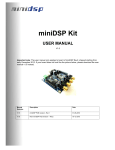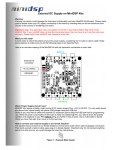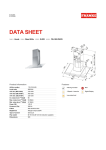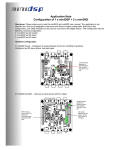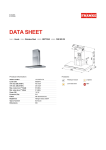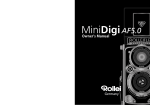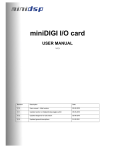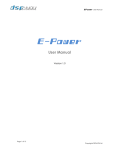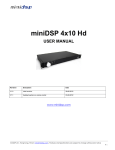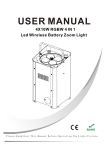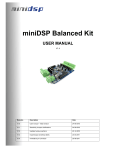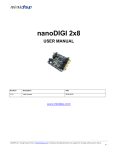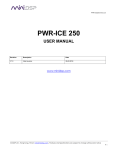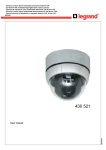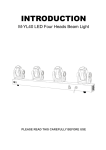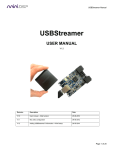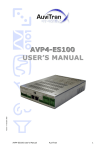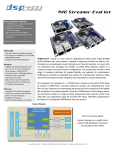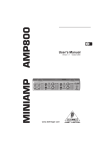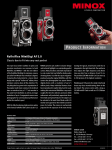Download miniAMP - User Manual
Transcript
miniAMP USER MANUAL V1.2 Revision Description Date V1.0 User manual – Initial version 25-02-2010 V1.1 Updated wiring section Updated jumper configuration 05-05-2010 V1.2 Updated wiring and instructions for 2.1 mode 05-08-2010 Board Diagram The following diagram shows the miniAMP board connectivity. Configuration Headers Power Input (12-24VDC) I2S routing headers PWM output for additional ouput channel Expansion connector J16 Expansion connector J2 Output jumpers: 2ch Bridge Tied Load (BTL) – Jumper closed 4ch Single Ended (SE) – Jumper open Speaker outputs See wiring configuration below Expansion Connector J16 Pin Description Pin Description 1 n/a 2 n/a 3 n/a 4 n/a 5 Ground 6 Ground 7 Ground 8 Ground 9 MCLKIN 10 I2S_DATA_IN1&2 11 I2S_DATA_IN3&4 12 I2S_DATA_IN5&6 13 I2S_DATA_IN7&8 14 I2S_IN_LRCLK 15 I2S_IN_BCLK 16 I2S_DATA_OUT1&2 17 I2S_DATA_OUT3&4 18 I2S_DATA_OUT5&6 19 IS2_DATA_OUT7&8 20 I2S_OUT_LRCLK 21 I2S_OUT_BCLK 22 3.3V 23 n/a 24 3.3V 25 GND 26 GND 27 n/a 28 n/a miniAMP Basics Before going any further, let’s summarize a couple of key points of the miniAMP: - miniAMP is a Full Digital amplifier module taking its signal from an I2S bus. In other words, no more potential ground loops. Your signal is digital all the way to the outputs of the amplifier. - miniAMP can be configured in 2ch (2x20W @ 8Ω) or 4ch (2x20W @ 8Ω) - miniAMP is a I2S slave device only which can automatically detect any type of incoming I2S signal (up to 192kHz) making it the perfect fit for your custom audio board. - miniAMP does not require any micro-controller programming and can operate in standalone mode. All it needs is a simple jumper configuration to select its mode of operation. I2S Expansion Bus 101 Configuration flexibility is a core design feature of the miniDSP concept. Using the I2S (Inter IC Sound) protocol, synchronized digital audio data is shared between boards. Besides the advantages of better noise immunity (vs analog audio), the choice of the widely known I2S protocol allows un-paralleled design freedom. While flexibility typically comes at the detriment of ease of use, the hardware jumper configuration of the miniAMP or miniDIGI boards allows a simple, yet reliable method to route the I2S data lines as you wish. I2S protocol consists of the following signals: - Clocks: They provides synchronization between ICs - I2S_IN: I2S input data lines carrying 2 x 24bit audio channels, in sync with the clocks - I2S_OUT: I2S output data lines carrying 2 x 24bit audio channels, in sync with the clocks miniAMP being an output device, only I2S_OUT lines are available for selection on the module. Let’s move on to the typical audio flow diagram of a miniAMP module Selection of input I2S channel Digital signal Analog signal OUTPUTS INPUTS I2S selection header I2S channels BTL /SE Header I2S Amplifier Control signals (Mute/Power down/Reset/Gain/ 2 or 4ch output) 2x20W (BTL) Or 4x10W (SE) Or 2.1Ch PWM SUB channels Step by Step configuration Please pay attention to the following diagrams to clearly understand how to correctly configure miniAMP: 1. STEP1: Configuring the miniAMP mode miniAMP may be used in 3 possible configurations: - 2 ch mode @20W each under 8ohms and in Bridge Tied Load (BTL) mode - 4 ch mode @10W each under 4ohms and in Single Ended (SE) mode - 2.1 mode with 2 ch @10W (SE/4ohm) and 1 ch @ 20W (BTL/8ohms) This configuration is done from the configuration header with a simple jumper switch and by the according output capacitor jumper. See below diagram for more info. 2. STEP2: Configuring the I2S routing Read the plug-in datasheet to figure out which I2S channels output your loaded plug-in will use on the miniDSP kit. This information is useful to understand how external I/O cards can link up to the miniDSP kit. Taking for example the 2Way PEQ Crossover plug-in, you can read in the technical specification section: Digital Inputs Digital Outputs Plug-in IN#1&2 selectable on I2S_Data_In7&8 Plug-in OUT#1/2/3/4 available on I2S_Data_Out1/2/3/4 Un-processed signal from ADC on I2S_Data_Out5/6 Un-processed signal from Digital IN on I2S_Data_Out 7/8 In other words, if you want the miniAMP module to receive the plug-in output from the miniDSP kit (processed audio, post filtering and crossover), you will need to select : - either I2S_Data_Out1&2 or I2S_Data_Out3&4 in a 2ch mode configuration - or both if a 4ch mode configuration. Here is a zoomed up version of the I2S routing and configuration header for the miniAMP. Configuration Header Closed Closed -3dB Closed Open 3dB Open Closed 9dB Open Open 12dB Config2 Config1 Closed Open Open Open Open Closed Mode 2ch mode 4ch mode 2.1 mode Factory default configuration 2ch mode (BTL), Gain @ -3dB Jumper symbol 4ch mode (SE) Gain @ -3dB 2.1ch mode (BTL + SE) Gain @ -3dB Power Down Mute Gain1 Gain0 Config2 Config1 Reset Gain Power Down Mute Gain1 Gain0 Config2 Config1 Reset Gain0 Power Down Mute Gain1 Gain0 Config2 Config1 Reset Gain1 I2S Routing Headers for selection of which I2S channel gets amplified Jumpers always closed for I2S clocks. Do not remove 1 2 3 3 2 1 0 Outputs 1&2 Outputs 3&4 0 Output jumpers 2ch mode: All Closed 4ch mode: All Open 2.1ch mode: ch1&2 Open, ch 3&4 closed I2S_Data_OUT_ch1&2 I2S_Data_OUT_ch3&4 I2S_Data_OUT_ch5&6 I2S_Data_OUT_ch7&8 Jumper position 2ch: I2S_Data_OUT_ch1&2 4ch: I2S_Data_OUT_ch1&2 2.1ch: I2S_Data_OUT_ch3&4 I2S_Data_OUT_ch7&8 I2S_Data_OUT_ch5&6 I2S_Data_OUT_ch3&4 I2S_Data_OUT_ch1&2 Jumper position 4ch: I2S_Data_OUT_ch3&4 2.1ch: I2S_Data_OUT_ch1&2 Jumper symbol: 3. STEP3: Stacking miniAMP on top of a miniDSP/DIGI board miniAMP is a I2S slave only device that requires clock & data from an I2S master device (miniDSP/miniDIGI). When stacking miniAMP, here are the potential configurations: - miniDSP (MCLK Slave) + miniDIGI (I2S Slave) + miniAMP (I2S Slave) - miniDIGI (I2S Master) + miniAMP (I2S Slave) - miniDSP (MCLK master) + miniAMP (I2S Slave) Please refer to the respective manual of each product for information on master/slave configuration. Boards share I2S and power by installing provided link cables on each side of the board. Standoffs for board to board connection. Bottom board standoff is secured with a bolt. Link cables on each side of the board allow sharing of the expansion connector signals( I2S & power) All output connectors on the same side. Note: To quickly confirm your jumper configuration, please use the Jumper Chart available in the download section of miniDSP website. 4. STEP4: Providing DC power to the device Before connecting your speakers to the miniAMP outputs, we strongly recommend to perform a test run without your speakers connected. See below symbol of the polarity of the DC connector miniAMP can operate from any DC power supply ranging from 12 to 24VDC. However, for best performance, an 18-24VDC supply rated at 2.5A/ 60W is recommended. Even with its good Power Supply Rejection Ratio (PSSR) specifications allowing it to reject noise from the supply, we would still advise you to select a good quality DC supply. Finally, note that a single power supply to the miniAMP module will provide power to all the other boards stacked in this configuration. Important: Connect the DC jack before turning on the power supply to prevent any potential damage. Turn On the power supply and make sure the blue LED on the module turns on. If this step is un-successful for any reasons, please contact our tech support team before moving further along. 5. STEP5: Wiring speaker cables to the module With the amplifier turned OFF, connect your speakers to the module as shown below. Depending on the miniAMP mode (2ch, 2.1, 4ch), speaker wiring and output jumper configuration is different so please make sure to pay attention to the following diagrams 4 Channel Mode (SE) 2 Channel Mode (BTL) + CH1 - + - + - CH1 CH2 + CH2 - + - + - CH3 Warning: All output jumpers removed in 4ch mode Warning: All output jumpers in place in 2ch mode 2.1 Channel MODE (SE + BTL) + - CH4 - + + - CH1 CH2 CH3 (SE) (SE) (BTL) Warning: CH2 requires to be wired as shown on the diagram, otherwise the channels will be out of phase. 6. STEP6: First test Time to listen to your miniDSP Rig! Before doing so, we however strongly recommend that you insure levels are turned down in your miniDSP plug-in configuration or at your digital audio source. This is to prevent any un-configured filters or any other DSP settings to potentially harm your audio system. Enjoy! Disclaimer As with any other products, we strongly recommend to exert caution when setting up your miniAMP system. Improper configuration of the device could potentially damage your system and DSP4YOU Ltd cannot be held responsible to any damage resulting from use of this product. In doubts or if you have any technical questions you’d like to clarify, don’t hesitate to contact our technical support team on the miniDSP forum or directly by email at [email protected]






